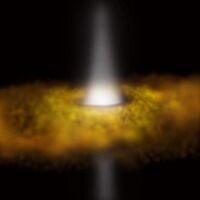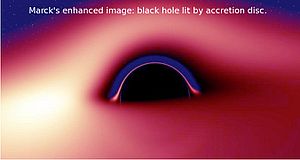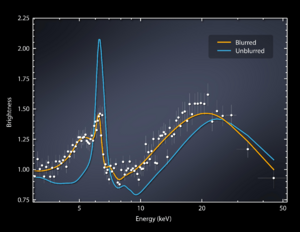Accretion disk facts for kids

An accretion disk is a structure in space that looks like a flat, spinning pancake. It is made of gas, dust, and plasma orbiting around a massive object. This central object is usually a star or a black hole.
Gravity pulls material inward toward the center. As the material moves, forces like friction and magnetic fields cause it to swirl in a spiral shape. This movement makes the material rub together, which creates a lot of heat. The disk gets so hot that it glows and sends out energy as light or X-rays.
Scientists call the study of how these disks wobble and move diskoseismology.
Contents
Where Do We Find Accretion Disks?
Accretion disks are very common in the universe. They can be found in:
- Active galactic nuclei (the bright centers of galaxies)
- Protoplanetary disks (where planets are born around young stars)
- Gamma ray bursts (huge explosions in space)
Often, these disks create astrophysical jets. These are powerful streams of gas that shoot out from the top and bottom of the disk near the central object. These jets help the system get rid of extra spinning energy (called angular momentum) without losing too much mass.
The brightest disks are found around quasars and active galactic nuclei. These are thought to be supermassive black holes at the centers of galaxies. As gas falls into the black hole, it spirals inward. The particles in the gas bump into each other, creating friction. This friction makes the gas lose speed and fall to a lower orbit, closer to the black hole.
As the gas gets closer, it moves faster and gets hotter. Just before it falls into the black hole, it can become hot enough to give off X-rays.
Some disks form in binary systems, where two stars orbit each other. If one star is a heavy object like a white dwarf or black hole, it can pull gas off its companion star. This gas forms an accretion disk around the heavy star.
Disks around young stars are called protoplanetary disks. The gas and dust in these disks eventually clump together to form planets.
The Science Behind the Disks
In the 1940s, scientists started using physics to understand how these disks work. They realized that for matter to fall inward, it has to lose energy. Since energy cannot just disappear, it has to be moved outward to the edges of the disk.
Scientists originally thought the gas was just sticky (viscous), like honey. However, simple stickiness was not enough to explain how fast matter falls in. They discovered that turbulence (chaotic swirling) and magnetic fields play a big role.
The Alpha-Disk Model
In 1973, scientists Shakura and Sunyaev created a famous model to explain this turbulence. They used math to describe how "sticky" the disk is. They called this stickiness parameter alpha ( ).
).
This model helps astronomers predict how hot and dense the disk will be. It assumes the disk is thin and can cool down by shining light. However, if the disk cannot cool down fast enough, it might puff up into a shape that looks more like a doughnut than a pancake.
Magnetic Fields
Later, in 1991, scientists Balbus and Hawley showed that magnetic fields are very important. They act like invisible rubber bands connecting different parts of the gas.
In a spinning disk, the inner parts move faster than the outer parts. This stretches the "magnetic rubber bands," which slows down the inner gas and speeds up the outer gas. This process allows the inner gas to fall toward the center while moving the spinning energy outward. This is called magnetorotational instability.
Magnetic fields are also thought to be the engine that launches the powerful jets seen shooting out from some disks.
Types of Disks
Thin Disks
When the disk is feeding the central object at a moderate speed, it forms a thin disk.
- It is very flat.
- It is made of relatively cool gas.
- It shines very brightly.
- This is the standard type of disk described by Shakura and Sunyaev.
When a thin disk is around a black hole, the strong gravity bends the light coming from it. This makes the disk look distorted to us, even though it is actually flat.
Puffed-Up Disks (ADAFs)
When the feeding rate is very low, the gas cannot cool down efficiently. The heat stays trapped inside the gas. This causes the disk to puff up.
- It looks more like a sphere or a doughnut.
- It is very hot but does not shine as brightly as a thin disk.
- Scientists call this an Advection Dominated Accretion Flow (ADAF).
Credit: NASA/JPL-Caltech
Thick Disks (Polish Doughnuts)
Why do some disks have wobbling patterns called Quasi-periodic oscillations?
If a black hole eats matter very quickly (faster than a limit called the Eddington limit), the disk becomes very thick.
- These are sometimes called "Polish doughnuts" because of their shape.
- They have narrow funnels along the center.
- Radiation shoots out of these funnels like a beam.
Excretion Disks
An excretion disk is the opposite of an accretion disk. Instead of material falling inward, material is pushed outward from the center. This can happen when two stars merge together.
See also
 In Spanish: Disco de acrecimiento para niños
In Spanish: Disco de acrecimiento para niños
- Accretion
- Astrophysical jet
- Circumstellar disc
- Circumplanetary disk
- Dynamo theory
- Gravitational singularity
- Ring system
- Solar nebula







